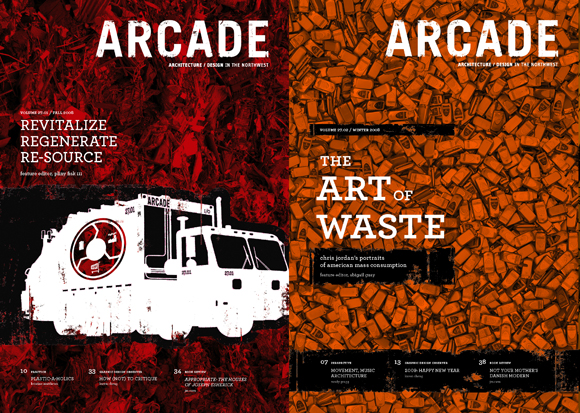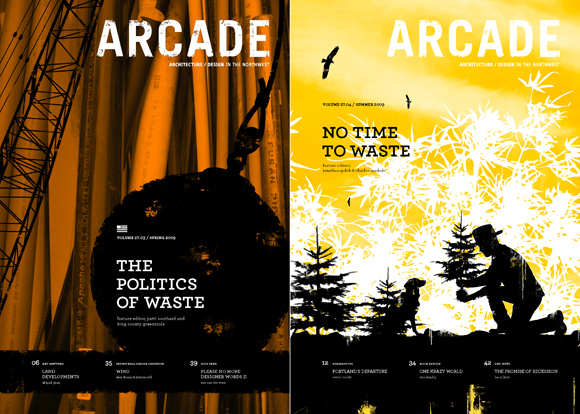The Seattle-based quarterly Arcade is that rare commodity, a critical west coast journal of ideas on architecture and design. Focused on the northwest, especially Seattle, Portland, and vicinities, Arcade sets a theme for each volume. Starting with its fall 2008 issue and continuing through the summer of 2009, the theme was waste—pragmatically, artistically, politically, polemically, and even apocalyptically considered. Here’s a quick rundown of what Arcade’s volume 27 covered.
“Revitalize, Regenerate, Re-source,” edited by Pliny Fisk III (27.01), starts it off. A preface of sorts is provided by Kristine Matthews, who documents the garbage island, 300-feet deep and twice the size of Texas, that’s floating in the Pacific between California and Hawaii. Fisk’s introduction includes the astonishing statistic that, by 2004, recycling was already pulling in the same revenue—$204 billion—as the US auto industry. Urban Ore’s Dan Knapp makes a convincing case that landfill (old-style “waste management”) is unworkable, but that waste managers (and the cities that contract with them) don’t recycle in a way that could avoid it. Fisk has the last word, arguing for the necessity (and showing the feasibility) of tracking the inputs and outputs of the US economy in order to bring it into sustainable balance. The AIA was a sponsor of this idea in the 1990s, and by 1999, Al Gore was on board. Unfortunately, he lost.
“The Art of Waste,” edited by Abigail Guay (27.02), features—in gorgeous color on Arcade’s tabloid-size pages—the photographs of Chris Jordan, whose subject is “the immense scale of our consumption.” At the 2008 TED Conference, he noted his desire to show the waste itself, as the statistics alone miss the real story: mountains of scrap metal, pallets, crushed cars, and baled paper; oceans of plastic bottles (every five minutes, Americans use two million of them); and vast walls of closely-packed paper grocery bags (1.14 million used per hour in the US alone).
“The Politics of Waste,” edited by Patti Southard and King County Greentools (27.03), brings waste down to the ground, asking how Seattle and its region can address the issue comprehensively by eliminating obstacles—political and otherwise—to recycling and reuse and exploiting new approaches at every step in the process. The issue is globally informed in terms of practices and possibilities, but its main examples are local—including a “reality check” interview with progressive Seattle council member Richard Colin, who notes the goal (“zero waste”) and the problems ahead (convincing people to do it).
“No Time to Waste,” edited by Jonathan Golob and Charles Mudede (27.04), is the least regionally anchored of the four issues. Perhaps this is inevitable when you’re trying to cite the “big issues” with their potentially dire environmental consequences. There are articles on concrete (a locally-sourced, possibly more sustainable building material) and everyday green practices that are sometimes counterintuitive (dishwashers are much greener than washing dishes by hand, for example), but the rest is like Massive Change, the Bruce Mau production that gave scores of “likely suspects” a spread each. It’s a seductive but reductive format. Like TV’s talking heads, they start to sound alike. There are new faces here, but the effect is similar. It would be more in the spirit of Arcade’s geographic specificity if the melting of the Arctic ice shelf, for example, were discussed in terms of its likely consequences for Seattle and its region.
That said, most of volume 27 focuses on the practicalities of changing how we do things, from top to bottom, so the consequences won’t be so dire. It does a good job of explicitly connecting the dots between actions and consequences, while pointing to new and different approaches that, if used more generally, would definitely make the current situation better. The four issues provide a kind of tutorial on the topic, sufficient to prod readers to act and give them some direction.
What makes Arcade Arcade
Woven in are all the other things that make Arcade such a remarkably good publication. Being an independent journal, it’s willing and able to publish solid criticism and polemics. (Further south, only the similarly independent California edition of The Architect’s Newspaper does this among print journals.) Volume 27 includes well-written, locally-knowledgeable criticism of “high design” targets like Miller-Hull; a debate between the critic Trevor Boddy and the planner Andres Duany of the latter’s New Urbanist suburb in southern British Columbia; Boddy’s long and wonderful piece on architectural criticism; Barry Katz’s musings on design in a non-material era; and Jim Cava’s long book reviews and his essay on cultural sustainability.
Cava is from Portland, Boddy from Vancouver, and Katz from San Francisco. Arcade’s ability to pull writers in from outside Seattle speaks to its singularity as a serious west coast journal that can invest time and ink on major themes and important issues. As Boddy notes, architectural criticism is increasingly missing in action in the mainstream US design press and in the major dailies. The LA Times has Chris Hawthorne and the SF Chronicle has John King, but Seattle and Vancouver’s daily papers no longer have architecture critics. Boddy suggests that the web will be increasingly the place to find serious discussion of architecture and design, especially on a regional basis.
The question of web versus print
Looking at my copies of journals from the past like Archetype and Design Book Review, it’s clear that print has the edge in terms of sheer longevity, yet the web offers immense leverage in terms of the minimal cost of its “real estate” and distribution. Even Arcade, which is lavish by current print standards—up to 48 of the largest tabloid-size pages per issue—bumps up against the limits of the medium. Dedicating a volume to a theme makes for a “bigger book” overall, allowing Arcade to devote the entire feature well of one issue to the photos of Chris Jordan, for example—an extravagance that’s justified by the theme. A blog can more easily build that theme over time, and do so in parallel with the development of other themes that are equally timely.
Do Jordan’s photos have a greater impact when you see them in print than on the web? This question applies equally to buildings. In his discussion of architectural criticism, Boddy notes how film adds considerably to our understanding of architecture and may be a better medium for conveying it than the traditional print-based case study. A web journal can include the films. The interface may be dreadful and the resolution deficient—a laptop screen isn’t even a home theater, let alone a movie palace. Still, you learn something seeing a building filmed that you don’t necessarily get from photos and drawings. There’s also less possibility for the artistry of the photographer to obscure the building’s deficiencies.
Shifting to the specific
An essay by Cava in Arcade 27.03, “[In]significant Places,” cites Allison and Peter Smithson, advocates (at a CIAM conference in 1953) of a “shift to the specific” in order to counter orthodox modernism’s tendency toward a “universal order” they found placeless. The phrase could be applied equally to Arcade, which owes its resonance to its willingness to home in on a region anchored by cities that are closely attached to the regional ecosystems that sustain them. What the Smithsons were resisting was the top-down, reductive nature of the modernist vision. What they proposed was to give authentic, place-centered content to what could all too easily become an abstraction, a lifeless diagram. The same comment could be made about a lot of “global” commentary about nature—that it raises the issue to an order of magnitude that we can’t easily fathom. This is the photographer Chris Jordan’s point: you have to see it to get it.
Arcade exemplifies specificity, lending authenticity and relevance. The strength of volume 27 is its willingness to focus on a topic and ground the discussion in the place itself. Reading the articles in Berkeley, the ones that stuck either address my own community (Dan Knapp of Urban Ore lives here and is writing about our local landfill), describe what other communities are doing, or—in the case of Jordan’s mountains of waste, Matthews’s garbage island, and Golob and Mudede’s rundown of “green/not green” practices—are directly applicable (if not a direct rebuke) to everyday life in these United States. That these articles typify volume 27’s waste theme shows just how well Arcade is put together. Next up (volume 28) is a new alchemy, an investigation of “design in an age of progressing climate change.” Those four issues can be yours for just $30 (arcadenw.org). Don’t miss out!
Author John Parman is an editorial adviser to the California edition of The Architect’s Newspaper who also writes for the web (www.j2parman.com).
Originally published 3rd quarter 2009, in arcCA 09.3, “Beyond LEED.”







